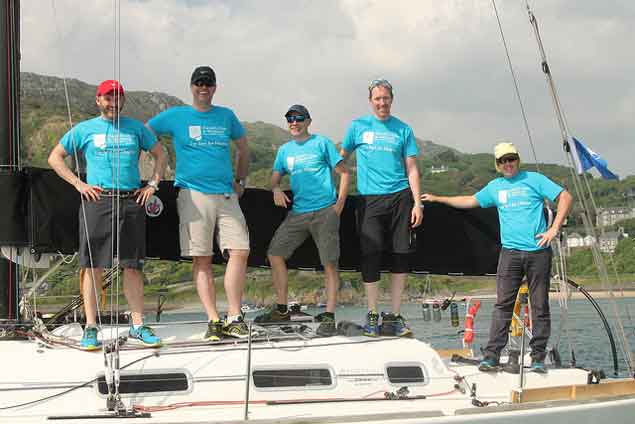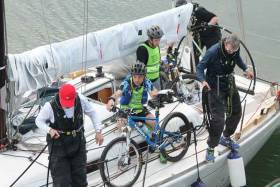Displaying items by tag: Three Peaks Yacht Race
Entry Now Open for Three Peaks Yacht Race in 2023
Entry is now open for the Three Peaks Yacht Race which celebrates its 45th year in 2023.
Regarded as the oldest multi-sport endurance race in the world, the Three Peaks race is a combination of yacht racing and summit runs up the tallest peaks in Wales, England and Scotland.
Ireland has previously enjoyed success in the four-day endurance challenge, with Magic Touch — an Irish Beneteau First 34.7 — claiming the IRC trophy and placing second overall in the 2018 race, as previously reported on Afloat.ie.
For more information on and details of how to enter the Barmouth to Fort William Three Peaks Yacht Race, starting on 10 June 2023, see threepeaksyachtrace.co.uk.
Three Peaks Yacht Race Success for Irish Boat 'Magic Touch'
After a slow, light airs start to the 2018 Three Peaks Yacht Race, Irish boat Magic Touch, a Beneteau First 34.7 racing as 'Team Digital Built Consultants' crewed by Steve Hayes (owner), John White, Mal Moir and runners Ian Alcock and Des Tivnan, claimed the IRC sailing trophy and second overall after over four days of continuous sailing, running and cycling and raised over €3,000 for the Blackrock & Harold’s Cross Hospice in the process.
The race, one of the oldest and considered one of the top ten toughest endurance races in the world, takes competitors from Barmouth in Wales to Fort William in Scotland via the tallest peaks in Wales, England and Scotland.
It involves 389 miles of sailing, 30 miles of cycling and 60 miles of mountain ascent and descent and rowing the yachts is permitted!
 Magic Touch to weather won the IRC sailing prize in the Three Peaks Race Photo: Rob Howard
Magic Touch to weather won the IRC sailing prize in the Three Peaks Race Photo: Rob Howard
The boats started in Barmouth at 17:00 on the 9th June in a falling breeze from the NE.
Digital Built Consultants was the first of the race fleet to get to the infamous Bardsey Sound through a mixture of rowing and sailing, using a new Code Zero from UK Sails bought specifically for the event but had to fight for over two hours to get through the notorious tidal race in a light and fluky breeze, which gave the other boats a chance to catch up.
"The crew raised over €3,000 for the Blackrock & Harold’s Cross Hospice"
The wind remained light and variable through the night and daybreak saw Digital Built Consultants back on the oars to make progress towards Caernarfon.
 Magic Touch, a Beneteau First 34.7 racing as 'Team Digital Built Consultants' crewed by Steve Hayes (owner), John White, Mal Moir and runners Ian Alcock and Des Tivnan
Magic Touch, a Beneteau First 34.7 racing as 'Team Digital Built Consultants' crewed by Steve Hayes (owner), John White, Mal Moir and runners Ian Alcock and Des Tivnan
The winds filled in in the morning and after sailing over the Caernarfon bar as far as the “Mussel Bank” mark, Digital Built Consultants was the first race boat to drop their runners at approx. 12:30 for the ascent of Snowden. Team Ajax, the Royal Armoured Corps Yacht Club in a J109 approx. 50 minutes later then Baloo a Sigma 33 and Wild Spirit, a Jeanneau 40 a further 10 minutes later.
Wild Spirit’s runners were the first back on board, followed by Digital Built Consultants 30 minutes later and then Baloo a further 30 minutes later.
All race boats opted to go around Anglesey rather than the shorter but trickier route through the Menai Straits.
Digital Built Consultants took the most westerly course and picked up the filling westerly breeze on Monday morning and were the first to cross the finish line at Whitehaven at 18:29 on Monday. They had to wait almost an hour for enough water to access the loch gate into Whitehaven marina, but their runners were on the road by 20:00.
Wild Spirit finished second on the water approx. 1:20 later but their runners need some recuperation before starting their run after a lumpy passage from Caernarfon.
Baloo and Ajax followed into Whitehaven approx. 2 hours later.
The earliest lockout time from Whitehaven on Tuesday morning was 8:15 and Digital Built Consultants & Wild Spirit went out together, along with Team Smithers Purslow, one of the challenge class boats who had the option to motor rather than sail or row. It was effectively a two-horse race at this point and Digital Built Consultants opened up a lead over Wild Spirit in the light winds but as the wind and seas built through the day and into the night, the difference in speed reduced and a match race up the North Irish Sea ensued with Wild Spirit covering Digital Built Consultants from behind.
Both boats made it to the tidal gate of the Mull of Kintyre with little time to spare and turned NE for the long downwind leg to Fort William through the spectacular Loch Linnhe.
Wild Spirit, flying asymmetric spinnaker were able to sail a direct course while Digital Built Consultants used asymmetric spinnakers and had to sail the gybe angles. The lead changed several times and as the wind built and conditions deteriorated, Digital Built Consultants pushed hard holding a spinnaker in over 30 knots of breeze to close the gap on Wild Spirit. After many gybes up the last 4 miles into Fort William, Digital Built Consultants finished 30 seconds behind Wild Spirit on the water.
The final Run up Ben Nevis was postponed until Thursday as Storm Hector made the conditions on the summit too dangerous for an ascent.
Team Ajax and Team Baloo were caught out in the storm and both saw gusts in excess of 60 knots, but both made it to Fort William relatively unscathed
All the runners started the final shortened run together on Thursday at 14:00 with Wild Spirit’s runners getting back and getting the overall win with a total time of 4 days, 2 hours & 13 minutes (sailing 3 days, 8 hours 0 minutes / running 13 hours 22 minutes)
Digital Built Consultants finished second overall with a total time of 4 days, 2 hours & 54 minutes (sailing 3 days, 5 hours and 36 minutes / running 17 hours 26 minutes)
Baloo were third at 4 days, 5 hours & 31 minutes (sailing 3 days, 9 hours & 19 minutes / running 16 hours 51 minutes) & Ajax fourth at 4 days 16 hours & 41 minutes (sailing 3 days, 19 hours & 46 minutes / running 20 hours & 7 minutes)
Go Sailing Association retired in Whitehaven as they did not think they would get to Fort William before Storm Hector arrived, but their runners did drive to Scotland and climbed Ben Nevis.
For more details about the race see the race website here
They are happy to help put teams together and would welcome more Irish boats into the race which takes place from June 15th next year.
Combine Sailing, Running & Cycling in Three Peaks Yacht Race
The Three Peaks Yacht Race is one of the oldest and most remarkable multi-sport endurance races in the world. It is a unique event combining sailing, running and a little cycling; with the quirky feature that rowing is allowed in moments of calm. It takes competitors through some of the most spectacular scenery that the United Kingdom has to offer and truly challenges the sailors' navigational expertise.
In 2011, in the biggest and most competitive race in the 34–year–history of the Three Race, the Irish boat 'Danu Technologies', skippered by Glen Ward, stayed ahead of the competition to win in a time of 77 hours 37 minutes.
Teams of four or five per yacht sail from Barmouth on the west coast of Wales up to the finish in Fort William on the west coast of Scotland. Two of the crew are required to climb each of the highest mountains in Wales, England and Scotland en route, thereby running the equivalent of three marathons in 3 or 4 days.
Entries are now open and the organisers would welcome enquiries. There is an early bird discount; £800 till the 1st March and £900 after.
Email [email protected] for further information
Racing Round Up: Lasers, E Boats, Puppeteers,DBSC, VDLR, Royal Cork, Cove and Sailor of the Month
In Cork Harbour 'Mid-Summer Madness' regatta attracted 40 Boats. We have the photos. There was a Fun Time for Cruisers at Cove Sailing Club's 'At Home' Regatta.
Galway's Martin Breen is June's Sailor of the Month and the Waterford Tall Ships Parade of Sail Photos are here.
Reasons to be cheerful? You bet. Click here to read how Dublin Bay sailors celebrate these wins.
























